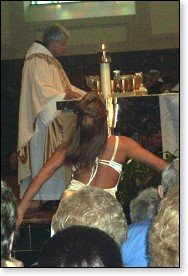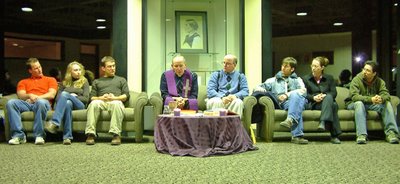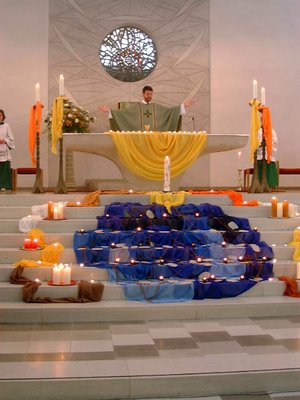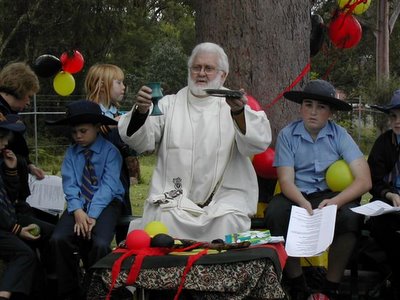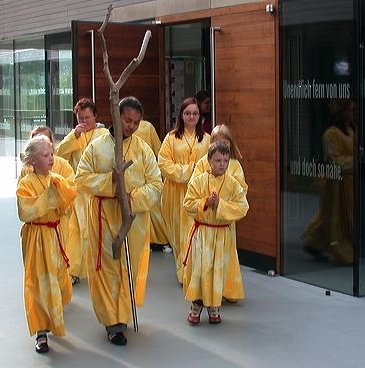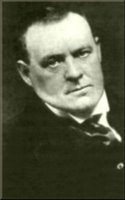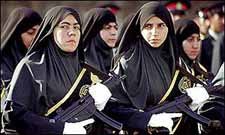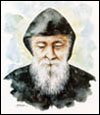 At the wonderful old age of 91, my mother passed away on October 16, 2006. Obviously, there have been other things to do than blog, but time waits for no one and life continues.
At the wonderful old age of 91, my mother passed away on October 16, 2006. Obviously, there have been other things to do than blog, but time waits for no one and life continues. My mother was a wonderful woman. Of course I would say that. But she really was! Sadly many do not have the mother that I was fortunate enough to have. An old musical colleague prima donna type whose mother passed away a few months ago chanted the song from The Wizard of Oz, in celebration "ding dong the witch is dead."
How sad...how terribly sad.
My mother, Martha, suffered much in her old age the maladies of a life long lived and in service to others. A broken leg, hip and collarbone were all due to falls because no doctor could figure out she needed something as simple as a pacemaker.
But at 82, she underwent emergency surgery for a thoracic aneurysm of the aorta and lived to become famous for it in Toronto emergency rooms. "She had a what?" the nurses would ask, incredulously. So, maybe the system wasn't so bad after all...at least not then!
A few years ago, on New Years Eve, she lost her first son, Raymond; he lost his son, Christopher, her eldest grandson to cancer a few years before--not something a great-grandmother should have to go through; but inevitably, some of the things that happen when you live into your tenth decade.
She always maintained that one of the reasons that she was living so long was that she had something to live for. She wasn't hidden away in a nursing home. She had support from her family and she lived with me. My 18 year-old son whom she helped me care for since he was 3 kept her young. She looked at the ear-ring, nose-ring, lip-ring, blue hair, green hair, purple hair, spiked hair, leopard-skin hair and tatoo with humour and reminded me that he was a "teenager" and that these things too would pass.
Ten years ago, a neurologist diagnosed her as having Alzheimer's. Even her personal physician agreed last year that it was a mis-diagnosis; either that or Aricept is a wonder drug for the treatment of Alzheimer's Disease.
She lived with me, and other than needing help to walk due to a most crippled body from osteo-arthritis, she was functioning fully with all her senses and faculties. Sight, hearing, speech and an appetite as if she was 20. She still charmed everyone she met. She was as sharp on the day she died as she was twenty years ago.
Four days before she died, I turned fifty. A week earlier she wished me a Happy Birthday. I said "Mum, it's next week." "Well" she replied in her ever happy way, with a wink in her eye, "that's just in case I'm not here on your birthday." No doubt, she was tired...she wanted to go, and she was ready.
We had a talk that Friday night two weeks ago as I write this and three days before she died. I acknowledged to her that I understood how hard it was for her. She replied that, "I'm ready to go whenever the good LORD takes me." Well, I told her that when she got to heaven (that I thought God would consider her purgatory was her suffering here on earth) that she needed to remember to pray for me so I would get there too. I said I would miss her when she was gone and she replied, "I'll miss you too!" "Nah," I replied, "You won't miss me, you'll be too busy with St. Charbel and St. Rafqa (a reportedly distant cousin) and making grape-leaves with Aunt Rose for Jesus!" Later in the night she called from her room for me. I asked what she needed, thinking perhaps she needed to use the washroom and she replied, "nothing, I just wanted to know where you were." It was as if she knew it would not be long.
But that's the way we were. And, that's the way she was. She did not fear death. First, she had faith and second, she saw lot's of death in her life and she knew, as best as anyone could know, what to expect. We joked and she understood when I lost my cool at someone or something stupid...a not uncommon trait for me; but she was always there with the sage advice: "Save the trouble, David," she would say. "Save it, save it for what?" I would reply. But she was right. Don't sweat the small stuff. Let it roll of your back. You have thick skin. Be the bigger man. All of these old sayings and cliches that are around because they're true! But more than that, in her own way, she was still teaching the Gospel of Christ. "Turn the other cheek." "Forgive those who persecute you." "Know that they have persecuted me and that they will persecute you." "Love your enemies." She lived it, she taught it and in her old age she prayed for all her family that they would either come back to it, or never lose it.
She left Fredericton at 21 and came to the big city of Toronto where she studied for that nursing career at St. Michael's Hospital in Toronto in the days when the big hospitals all had nursing schools. She loved the old Silver Rail at Shuter and Yonge, Massey Hall, St. Michael's Cathedral, the Sisters of St. Joseph and her nursing vocation. She loved chocolate, kibeh, Lebanese Arak, Captain Morgan Rum and Crown Royal Canadian Whiskey. She smoked menthol cigarettes until she was 88!
Being a nurse in the old days, comfortable running shoes in hospitals were verboten! Nurses wore a white uniform and the starched hat, white stockings and hard leather-soled shoes. Not terribly comfortable on the hard terrazzo floors of St. Mike's. But they looked great in that white uniform under a black wool cope!
They also did more hands on work back then. Fortunately, they could. There were no computers and not anywhere near as much paperwork. They were expected to, well,--nurse. And nurse they did! They lifted patients twice as heavy or more as themselves, cleaned the bedpans, closed the eyes of the dead and said a little prayer. All in time to take the verbal abuse from the holier-than-thou Doctors who thought they were gods unto themselves. But they loved the nuns at St. Mike's and St. Joe's and the hospitals were caring, cost-efficient centres of love and healing. Now there are no nuns the hospitals are not as caring and not as cost-efficient and certainly not as clean.
Before she was a nurse, she was a teacher in Fredericton, New Brunswick. Figuring she'd probably swat some kid for saucing her; she thought she should give up teaching before getting in trouble. Later in life, when I was a young lad, she did return to supply teach in Toronto because of the convenience. That and the ever-present nurses midnight shift so she could be home during the day...when did she sleep?
She met her husband through nursing his mother Farida Doumit. My grandmother ran a boarding house and my grandfather had a grocery store downstairs in a building at 198 and 1/2 Queen Street. Yes there is a "one-half" in the address and the building still stands there today, down the street from St. Patrick's Church and across from the old Rex Hotel. As the story goes my mother heard Farida talking Arabic (Lebanese) and started up a conversation. Well as any good Lebanese mother would do, Farida said to come over for dinner sometime. So after she got out of hospital over my mother went for dinner. The shy guy at the table, Norman, was scolded by his father, Wadea to "get up and walk her home." It was about 6 big city blocks from Queen and St. Patrick to Victoria Street and Shuter. They must have had a good chat on the way, the rest of course, is history.
She did it all.
Two careers, wife, mother of four, neighbourhood nurse, Catholic Women's League President, Moose Lodge Officer and much, much more. She never complained. She just did it! It was done for faith, family and love.
 Martha's funeral took place last Saturday, October 21 at the Toronto Oratory Church of the Holy Family. This was my mother's second parish. She spent the last 15 years of her career as the Director of Nursing in a large nursing home in the same Parkdale neighbourhood. She made it a place of compassion as did the very Catholic owner.
Martha's funeral took place last Saturday, October 21 at the Toronto Oratory Church of the Holy Family. This was my mother's second parish. She spent the last 15 years of her career as the Director of Nursing in a large nursing home in the same Parkdale neighbourhood. She made it a place of compassion as did the very Catholic owner. They were good peopl
 e, he and his wife were nothing like one would read about private nursing homes and, they had a strong, religious, caring, compassionate woman in charge. She even found room at the White Eagle for her old aunt, her mother's sister Eva Deeb who buried husbands and children. Born in Lebanon, old Aunt Eva or "Marcola" died at 97. Of the nine children born to Martha's parents, four made it into their 90's, four died into their 80's and the last one, my godmother Francis, is still going strong at a local nursing home...she will be 99 on January 3, God willing it. (died at 104)
e, he and his wife were nothing like one would read about private nursing homes and, they had a strong, religious, caring, compassionate woman in charge. She even found room at the White Eagle for her old aunt, her mother's sister Eva Deeb who buried husbands and children. Born in Lebanon, old Aunt Eva or "Marcola" died at 97. Of the nine children born to Martha's parents, four made it into their 90's, four died into their 80's and the last one, my godmother Francis, is still going strong at a local nursing home...she will be 99 on January 3, God willing it. (died at 104)I suppose at these ages you pretty well outlive anyone you knew. We joked at the funeral where over 200 attended and 130 sat down after her interment for the "mercy feast" that if she died 10 years earlier, they'd have been overflowing on the street at the church; such was her life; such was the state of her family and friends with so many gone.
My parents did all the things expected of them for a Catholic family in parish life. In fact, it was not out of expectation that they did it and while it was certainly their duty, they always did it with joy. It was just such a natural part of their life. There was no TV and when they bought the first one just after I was born in 1956, there were only two stations; there was no internet, no other worldly diversions. There was home, family and the church. The Catholic Womens' League, Holy Name Society, Altar Guild, Altar Boys, bazaars, fund-raising for the new Catholic school, the new church and so much more.
My family was, and I know my mother would have been, honoured that Father Jonathan Robinson, C.O., the Superior of the Oratory celebrated the Requiem Mass of Christian Burial for her. Father Robinson always says a w
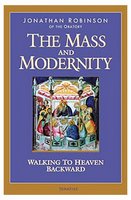 onderful, spiritual Mass. He did nothing different for my mother. I hope the people that came to the funeral not from Holy Family figure this out. He did nothing different than he would on a Sunday. This is not to say that he did not do anything special. He did! He said/sang the Mass as it was meant to be done, thouigh according to the Novus Ordo.
onderful, spiritual Mass. He did nothing different for my mother. I hope the people that came to the funeral not from Holy Family figure this out. He did nothing different than he would on a Sunday. This is not to say that he did not do anything special. He did! He said/sang the Mass as it was meant to be done, thouigh according to the Novus Ordo.He wore a splendid black chasuble with gold trim and design. The sacred vessels were covered in "black." The pall on my mother's coffin was dark purple with a black cross. Not the white that is presumptious that we all go to heaven. There was enough incense to create a run on Salbutimol, the Mass was in Latin, "ad orientem" with four altar servers, seminarians, a young reader with a charming British accent and Father singing the Gospel in English. I know my mother was always fond of Father Robinson from back in the early days of the Oratory. She would recall his blonde hair and smile. She loved the Latin Mass (was displeased with the reforms and preferred the Tridentine); she loved choral music, chant and high liturgy. The highly regarded Toronto Oratory Choir (I am an alumnus) under the direction of Mr. Peter Bishop, M.A., sang. It was a funeral Mass of great solemnity, dignity, prayer and of course, the worship of Almighty God. To me and I think to all of us there, it was also a Mass of Thanksgiving to God for her wonderful life.
The music was the Officium defunctorum a VI by Tomas Luis de Victoria 1548-1611--the stupendously beautiful, moving, overflowing with religiosity-Victoria Requiem.
Even those of none or little faith were moved. That's a good thing--maybe the Holy Spirit will be at work here.
From the opening Requiem aeternam through the Dies Irae to Father's sermon on the inevitability of death, the need to pray for Martha's soul, the need of all of us to proclaim Jesus Christ as LORD, to the "in Paradisum" it was the funeral my mother deserved.
She went by the old Lebanese belief that in everything God comes first followed by your spouse and then your children. She lived the Good News of Jesus Christ every day of her life. She accepted her suffering in the later years with grace and dignity and the will of God. She died the death we can all hope for, quietly, quickly in her own home. No doubt with her beloved St. Anthony of Padua, St. Joseph and of course Her's and Our Blessed Lady Mary at her side to help her.
She loved Jesus more than anyone I know.
She endured in her faith and the Eucharist nourished her in her suffering.
All of us should strive for the life and hope and for the faith and death of Martha.
Thank you Mum.
Thank you God.



